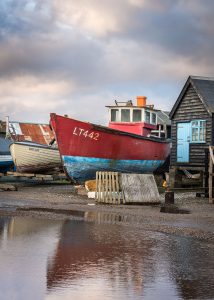Photographing detail and small scenes.
 As I walk along the edge of the River Blyth at Southwold Harbour the sun bounces across the fast flowing water and casts its soft winter light on a curtain of fishing nets hanging over some wooden staging at the waters edge. The light transforms the ugly nylon nets into something quite beautiful.
As I walk along the edge of the River Blyth at Southwold Harbour the sun bounces across the fast flowing water and casts its soft winter light on a curtain of fishing nets hanging over some wooden staging at the waters edge. The light transforms the ugly nylon nets into something quite beautiful.
I am out with my camera on the hunt for smaller landscapes and my afternoon of photography has become all about the tiny details around me. I love this type of photography because it forces you to observe and interact with things that you normally wouldn’t look at twice. It is also a very mindful style of shooting and you can get lost in the mundane for hours. The challenge is to make the ordinary look extraordinary.
Southwold Harbour is a quirky mix of commercial fishing and boatbuilding and the slightly more refined face of tourism. It is a place where traditional ways of life combine with modern excesses and the two extremes result in a really interesting place to photograph. It might look messy and run down in places but this is all part of its charm and the variety of subjects makes the edge of the Blyth a great place for intimate landscape and detail photography.
 Shooting detail is all about observation – learning to notice graphical shapes, lines, patterns, texture and colour and noticing how the light interacts with it all.
Shooting detail is all about observation – learning to notice graphical shapes, lines, patterns, texture and colour and noticing how the light interacts with it all.
Tips for shooting details and small scenes
Use a long lens or even a macro lens. Get up close and create an abstract feel to your images.
Shoot with a wide aperture and blur your backgrounds, this helps to isolate your subject but it also helps to emphasise the abstract nature of what you are photographing.
Use the light to your advantage. All my net images were shot into the sun, over exposing slightly to give a lovely soft feel to the images. Shooting into the light will also allow you to create some lovely bokeh with the out of focus highlights. Overcast days can also be good as you will have no harsh shadows to contend. Conditions like this are idea for detail or macro shots.
Use a low viewpoint and look across at your subject. This will give a more intimate feel to your shot compared to standing above your subject and looking down. A low viewpoint will also help emphasise any texture and will allow you to make the most of any bokeh.
Try shooting through elements within the frame to create blocks of colour at the front of your image. This works really well with flowers and vegetation but can also work well with manmade subjects.
Intimate landscapes work because they are simple images. They don’t contain too many elements, they often have a shallow depth of field, they generally don’t include the sky and are simple in their composition.
When you are out shooting try to think about shooting in series instead of just single images. Small detail shots can work really well as panels, but to do this you will need to think about combining images using similar colours, tones and lighting.
If you would like to try some detail and small scene photography at Southwold harbour I am running a Friday Photo walk on 3rd February – more details can be found here>>